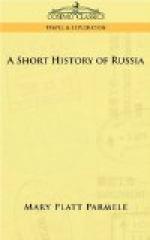It would be long before Christianity would penetrate into the heart of the people. As late as the twelfth century only the higher classes faithfully observed the Christian rites; while the old pagan ceremonies were still common among the peasantry. And even now the Saints of the Calendar are in some places only thinly disguised heathen deities and pagan rites and superstitions mingle with Christian observances.
The conversion of Vladimir seems to have been sincere. From being a cruel voluptuary and assassin, he was changed to a merciful ruler who could not bear to inflict capital punishment. He was faithful to his Greek wife Anna. On the spot where he had once erected Perun, and where the two Scandinavians were martyred at his command, he built the church of St. Basil; and he is now remembered only as the saint who Christianized pagan Russia, and revered as the “Beautiful Sun of Kief.”
So the two most important events considered thus far in the history of this land have been, first, its military conquest from the North, and second, its ecclesiastical conquest from the South. If the first helped it to become a nation, the second determined the character which that nationality should assume.
To explain one fact by another and unfamiliar and uncomprehended fact is one of the confusing methods of history! In order to know why the adoption of the form of religion known as the Greek Church so powerfully influenced Russian development, one must understand what that faith was and is, and the source of the antagonisms which divided the two great branches of the Church of Christ—the Greek and the Latin.
The cause underlying all others is racial. It is explained in their names. The theology of one had its roots in Greek Philosophy; that of the other in Roman Law. One tended to a brilliant diversity, the other to centralization and unity. One was a group of Ecclesiastical States, a Hierarchy and a Polyarchy, governed by Patriarchs, each supreme in his own diocese; the other was a Monarchy, arbitrarily and diplomatically governed from one center. It was the difference between an archipelago and a continent, and not unlike the difference between ancient Greece and Rome. One had the tremendous principle of growth, stability, and permanence; the other had not.
Such were the race tendencies which led to entirely different ecclesiastical systems. Then there arose differences in dogma; and Rome considered the Church in the East schismatic, and Byzantium held that that of the West was heterodox. They now not only disapproved of each other’s methods, but what was more serious, held different creeds. The Latin Church, after its Bishop had become an infallible Pope (about the middle of the fifth century), claimed that the Church in the East must accept his definition of dogma as final.




